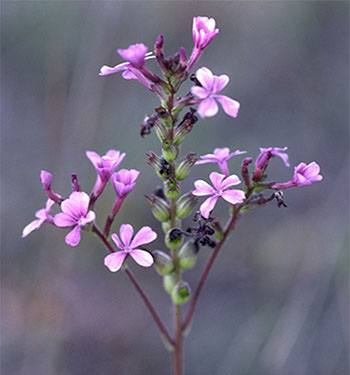Bluehearts

Species information
The following is a report on progress made towards the protection and recovery of Bluehearts (Buchnera americana) in Ontario from 2007 to 2020, based on Ontario’s species-specific recovery policy. This report meets the legislative requirement for a review of progress under the Endangered Species Act, 2007 (ESA or “the Act”). Bluehearts is listed as endangered on the Species at Risk in Ontario (SARO) List under the ESA.
Bluehearts has been classified as a species at risk since 2004. It was originally classified as an endangered species and was listed as such under the ESA when it came into force in June 2008.
Bluehearts has been protected from being killed, harmed, harassed, captured or taken since 2008.
In addition, the habitat of Bluehearts has been protected from being damaged or destroyed since 2013.
The species-specific recovery policy for Bluehearts, known as the Government Response Statement (GRS) was published in 2016 and includes the government’s recovery goal for the species and the actions and priorities it intends to lead or support to help achieve that goal. The GRS considers science advice provided in the recovery strategy when developing recovery actions for the species. As legislated in the Act, the purpose of this review is to report on progress made towards implementing the protection and recovery actions in the GRS. The review can also help identify opportunities to adjust and adapt the implementation of protection and recovery actions to achieve the recovery goal for the species.
Further information about Bluehearts, including the threats that it faces, and actions being taken to help protect and recover this species is available on the Government of Ontario webpage for Bluehearts. A summary on the progress towards the protection and recovery of Bluehearts and an annual update on the broader species at risk program (i.e. the Introduction to the 2021 Review of Progress report) is available on the Review of Progress towards the Protection and Recovery of Ontario’s Species at Risk webpage.
Snapshot: Progress towards the protection and recovery of Bluehearts
Progress towards meeting the recovery goal
- The recovery goal in the Government Response Statement (GRS) for Bluehearts in Ontario is to “maintain the current distribution of Bluehearts in Ontario and support natural increases in the abundance of Bluehearts, where feasible. The government supports investigating the feasibility of augmenting existing populations.”
- Progress has been made towards implementing all of the government-led actions. Progress has been made towards implementing two of the government-supported recovery objectives and two of the associated actions. Examples of progress include:
- monitoring of Bluehearts at Pinery Provincial Park and management of its habitat through methods such as prescribed burning and deer population control
- implementation of Ontario’s Invasive Species Strategic Plan, to reduce the impacts of invasive species, such as European Common Reed, that threaten Bluehearts
- research to improve knowledge of Bluehearts pollinator biology
- In alignment with the GRS, more work is required to:
- collaborate with partners to monitor existing and historical Bluehearts locations outside of Pinery Provincial Park
- undertake habitat management actions to address habitat degradation posing a direct threat to extant Bluehearts populations
- research the species’ life history characteristics and habitat requirements to inform recovery actions, and investigate the feasibility of augmenting existing populations
Occurrences and distribution
- Bluehearts is limited to within 500 metres of the Lake Huron shoreline between Kettle Point and Pinery Provincial Park, with a distribution of 12 square kilometres based on recent observations, and an additional eight square kilometres based on historical observations.
- The Natural Heritage Information Centre (NHIC) has received nearly 300 observations of the species based on observations made between 1910 and 2020.
- Since 2008, the species has been observed in multiple locations where it was not previously known to occur. Based on up-to-date information, the species’ extant distribution is estimated to encompass an area six square kilometres larger than was known since the ESA came into effect.
Government-supported stewardship projects
- Through the Species at Risk Stewardship Program, the Government of Ontario has enabled its stewardship partners to conduct four projects (by providing $168,997 in funding) that have supported the protection and recovery of multiple species at risk, including Bluehearts.
- The government’s support helped its stewardship partners to involve 276 individuals who volunteered 2,644 hours of their time towards protection and recovery activities for species at risk, including Bluehearts. The estimated value of these voluntary contributions, as well as additional funding and in-kind support, is $285,009.
- Stewardship partners reported that through their actions 15 hectares of habitat were enhanced for Bluehearts and other species at risk that inhabit the same ecosystem.
- Stewardship partners reported providing outreach on multiple species at risk, including Bluehearts, to 34,559 individuals.
Supporting human activities while ensuring appropriate support for species recovery
- One activity has been registered for the species under ‘Drainage works’ (section 23.9) under Ontario Regulation 242/08 of the ESA.
Reporting on the progress towards the protection and recovery of Bluehearts
Recovery goal
The government’s goal for the recovery of Bluehearts is to maintain the current distribution of Bluehearts in Ontario and support natural increases in the abundance of Bluehearts, where feasible. The government supports investigating the feasibility of augmenting existing populations.
The implementation of government-led and government-supported actions demonstrates progress towards reaching the desired objectives and the recovery goal set out in the GRS.
Progress towards implementing government-led actions
Progress has been made towards implementing all government-led actions identified in the GRS. Common actions for the government to lead as it works towards achieving a species’ recovery goal include:
- Co-operate with federal partners, such as Environment and Climate Change Canada, to implement protection and recovery actions, where appropriate.
- Educate other agencies and authorities involved in planning and environmental assessment processes on the protection requirements under the ESA.
- Encourage the submission of Bluehearts data to the Government of Ontario’s central repository at the Natural Heritage Information Centre.
- Undertake communications and outreach to increase public awareness of species at risk in Ontario.
- Protect Bluehearts and its habitat through the ESA.
- Develop direction to provide greater clarity to proponents and partners on the areas of general habitat protected under the ESA for species at risk plants.
- Support conservation, agency, municipal and industry partners, and Indigenous communities and organizations to undertake activities to protect and recover Bluehearts. Support will be provided where appropriate through funding, agreements, permits (including conditions) and/or advisory services.
- Encourage collaboration, and establish and communicate annual priority actions for government support in order to reduce duplication of efforts.
Additionally, the government has directly undertaken the following species-specific actions:
- Continue to monitor the Bluehearts population within The Pinery Provincial Park.
- Continue to manage the habitat of Bluehearts in The Pinery Provincial Park to improve suitability for Bluehearts using appropriate methods (e.g., modifications to enclosure fencing, redirecting recreational activities to other areas, removal of woody vegetation, prescribed burning).
- Continue to implement the Ontario Invasive Species Strategic Plan to address the invasive species (e.g., European Common Reed) that threaten Bluehearts.
Key progress made towards implementing these actions is described in the following sections.
Ontario’s Invasive Species Act
The GRS for Bluehearts indicates that invasive species (e.g. European Common Reed) pose a threat to the survival and recovery of the species in Ontario. The Ontario Invasive Species Strategic Plan, 2012 and the Invasive Species Act, 2015 provide the policy and legislative framework to prevent new invaders from arriving and surviving in Ontario; to slow and where possible reverse the spread of existing invasive species, and to reduce the harmful impacts of existing invasive species, including impacts on species at risk. This framework may support the implementation of actions to reduce the threats from invasive species.
Occurrences and distribution
Bluehearts is limited to within 500 metres of the Lake Huron shoreline between Kettle Point and Pinery Provincial Park. For this review of progress, the species’ occurrence information has been assessed at a landscape scale using one by one kilometre grid “squares” to approximate the species’ distribution. The squares were used to estimate where the species has been recently observed (i.e., has been observed within the past 20 years) as well as squares where the species is considered historical
Using this approach, the species has been recently observed in 12 squares, and there are eight additional squares with historical observations of the species. This equates to a potential range
The NHIC has received nearly 300 records of Bluehearts. The records are based on observations between 1910 and 2020. Based on records since 2008, the species has been observed in locations associated with six squares in which it was not previously known to occur, and the species’ presence has been re-confirmed in six additional squares.
This enlargement of the species’ estimated distribution is most likely the result of increased search effort and education about Bluehearts and represents increased knowledge on the distribution of the species. Efforts to engage citizen scientists in collecting data for this species have increased since 2008, with an assortment of programs and tools available for observations to be submitted and confirmed.
Encouraging the submission of observations of this species is included in the GRS as a government-led action. Submission of species observations increases our knowledge of where they occur and can play an important role in assessing the viability of species’ populations.
Everyone is encouraged, or may be required by an authorization or approval, to submit observations of Bluehearts, and any other species at risk, to the NHIC for incorporation into the provincial record of observations. Observations may now be submitted to NHIC via the Rare Species of Ontario project in iNaturalist.
-
201observations of this species were submitted to the NHIC since 2004
Government-supported stewardship projects
An important government-led action in the GRS for Bluehearts is to support partners to undertake activities to protect and recover the species. Through the Species at Risk Stewardship Program the government has supported four projects ($168,997) designed to contribute to the protection and recovery of Bluehearts. All of these projects focused on multiple species at risk, including Bluehearts. In addition to the government funding, partners with projects designed to benefit multiple species at risk, including Bluehearts, reported they were successful in securing additional funding ($285,009) from other sources. These amounts include in-kind support in the form of time and expertise provided by volunteers.
Stewardship partners reported that provincial funding helped them to secure in-kind support by involving 276 individuals who volunteered 2,644 hours of their time towards protection and recovery activities for multiple species at risk, including Bluehearts, which has an estimated value of $49,378. Partners also reported that through both their efforts and the efforts of their volunteers to implement GRS actions, they were successful in enhancing 15 hectares of habitat that will benefit multiple species at risk, including Bluehearts. In addition, stewardship partners reported providing ecosystem-based outreach on multiple species, including Bluehearts, to 34,559 individuals.
The remainder of this section highlights one project supported through the Species at Risk Stewardship Program as well as the corresponding government-supported recovery action for the species.
A project carried out by Wildlife Preservation Canada from 2013-2014 made progress on the high priority action to research the life history characteristics of Bluehearts. Insect visit surveys were conducted to better understand the pollination biology of six species at risk plants, including Bluehearts. Researchers observed Bluehearts in Pinery Provincial Park for two days and recorded each insect visit to determine which species may serve a role in pollinating Bluehearts.
Through this work, Wildlife Preservation Canada identified eight different species that visited Bluehearts flowers, representing a range of butterflies, hoverflies, and solitary bees. The surveyors noted that insects visited Bluehearts flowers less often and for less time compared to other flowering plant species in the study area, and only one visitor was carrying pollen. These results suggest that the potential for insect-facilitated pollination is low in this species. While further work is needed, this work provides an important first step in better understanding the life history of the species to inform future habitat management and recovery actions.
Species at Risk Stewardship Program
-
 4
4projects included Bluehearts
-
 $168,997
$168,997for multi-species projects that included Bluehearts
-
 $285,009
$285,009in additional funding and in-kind support
-
 276
276volunteers
-
 2,644
2,644volunteer hours
-
 34,559
34,559people received outreach
-
 15
15hectares of habitat enhanced
Supporting human activities while ensuring appropriate support for species recovery
Supporting partners through authorizations and their associated conditions is an important government-led action.
To date, no permits have been issued for Bluehearts, and no agreements were entered into for Bluehearts through Ontario Regulation 242/08 (prior to the July 1, 2013 amendment).
One activity that may affect Bluehearts or its habitat has been registered for the purposes of Ontario Regulation 242/08 under the ESA. The activity was registered under ‘Drainage works’ (section 23.9). This registration requires the registrant to comply with all conditions of the regulation, such as:
- preparing a mitigation plan using the best available information on steps that may help minimize or avoid adverse effects on the species
- taking reasonable steps to minimize or avoid the killing, harming or harassing of members of the species
- taking reasonable steps to control erosion and sediment, and to stabilize water banks in any area affected by the activity if the area is the habitat of the species
-
1registration
Progress towards implementing government-supported actions
Government-supported actions are organized under overarching recovery objectives. Progress has been made towards achieving two government-supported recovery objectives and implementing two of the associated actions identified in the GRS for Bluehearts.
Objective: Increase knowledge of the biological and habitat requirements of Bluehearts to inform future recovery actions.
- Action No. 4 (High Priority) – Research the species' life history characteristics and habitat requirements of the species (e.g., role of host species, pollination biology, recruitment rates, seed bank dynamics and seed ecology) to inform habitat management and species recovery actions.
Under this objective, initial progress has been made towards implementing Action No. 4. A project supported through the Species at Risk Stewardship Program examined the pollination biology of Bluehearts by surveying insect visits to identify possible pollinators of the species.
Objective: Maintain or improve habitat suitability by implementing management actions, reducing threats to the species, and increasing the level of awareness of Bluehearts.
- Action No. 8 – Promote awareness among Indigenous communities and organizations, landowners, land managers and land users, about Bluehearts by sharing information on:
- how to identify the species
- the species' habitat requirements
- protection afforded to the species and its habitat under the ESA
- actions that can be taken to avoid or minimize impacts to the species and its habitat
Under this objective, initial progress has been made towards implementing Action No. 8. A project supported by the Species at Risk Stewardship Program focused on community engagement in the Lambton Shores area, educating the public and local businesses about species at risk, their threats, and mitigative actions.
Summary of progress towards meeting the recovery goal
The recovery goal for Bluehearts is “to maintain the current distribution of Bluehearts in Ontario and support natural increases in the abundance of Bluehearts, where feasible. The government supports investigating the feasibility of augmenting existing populations.” Effort made towards the government-led and government-supported actions has helped to make progress towards this goal. For example, continued monitoring and habitat management at Pinery Provincial Park has promoted conditions required by the species. Implementation of the Ontario Invasive Species Strategic Plan and Species at Risk Stewardship Program continue to address threats and knowledge gaps. In addition, the provincial record of observation indicates that since 2008, Bluehearts has been discovered in six one by one kilometre grid squares where it was previously unknown. Although this increase in the known range likely reflects increased search effort rather than true expansion of the species, identifying the full range of Bluehearts is an important step in maintaining its current distribution.
Recommendations
As stated in the GRS, this review of progress can be used to help identify whether adjustments to the implementation of GRS actions are needed to achieve the protection and recovery of the species. Based on progress to date, the overall direction provided in the GRS for Bluehearts, particularly the implementation of actions identified as high priority, should continue to guide protection and recovery of the species.
Although initial progress has been made towards the action to research the species' life history characteristics and habitat requirements of the species, further work is required to fully implement this action. For example, research on breeding systems, recruitment rates, seed ecology and seed bank dynamics will help to address remaining knowledge gaps for this species. Additionally, although initial progress has been made towards the action to promote awareness about Bluehearts, further work is required to share information about the species, its habitat requirements, and actions that can be taken to avoid or minimize harm. Relative to actions that have received a higher level of support, the following actions have received less attention and are identified for consideration in future work towards the protection and recovery of the species:
- Action No. 1 (High Priority) – Develop and implement a standardized protocol to inventory and regularly monitor existing populations of Bluehearts and to document changes in population sizes, reproductive success and habitat quality.
- Action No. 2 – Collaborate with local Indigenous communities and organizations to survey areas of suitable habitat in the former Ipperwash Provincial Park (and other historic locations if suitable habitat is present) to determine whether Bluehearts continues to exist. As Bluehearts populations are known to fluctuate, survey timing should coincide with years when large numbers of plants are found in other Ontario populations to increase the likelihood of detection.
- Action No. 3 – Encourage the recording, sharing and transfer of Traditional Ecological Knowledge on Bluehearts as available, including information on the historical distribution of the species and conditions of its habitat (e.g., the historical frequency of wildfire within the species' habitat) to inform survey protocols and habitat management actions. Coordinate this with efforts for other species at risk plants which occur in the same ecosystem.
- Action No. 5 – Investigate the feasibility of augmenting existing populations of Bluehearts that are at risk of extirpation where sufficient suitable habitat is available for the species.
- Action No. 6 (High Priority) – Undertake habitat management actions to address habitat degradation, such as removal of woody vegetation (e.g., Eastern White Cedar) and invasive plants (e.g., European Common Reed) posing a direct threat to Bluehearts, while ensuring that methods employed do not adversely affect Bluehearts.
- Action No. 7 – Implement approaches to avoid or reduce the impacts of recreational activities on Bluehearts and its habitat, including:
- redirecting recreational activities away from the species
- erecting physical barriers, while ensuring that the barriers will not lead to the establishment of woody vegetation
- installing signage to alert people to the presence of the species
Protecting and recovering Bluehearts will continue to be a shared responsibility that will require the involvement of many individuals, organizations and communities. Financial support for the implementation of actions may be available through the Species at Risk Stewardship Program. The government can also advise if any authorizations under the ESA or other legislation may be required to undertake a project. By working together, progress can continue to be made towards protecting and recovering Bluehearts in Ontario.
Footnotes
- footnote[1] Back to paragraph A population is considered historical if it has not been recorded within the last 20 years. Historical populations may still exist, but updated information is not available.
- footnote[2] Back to paragraph A potential range of the species is estimated based on a one by one kilometre square grid where observations of the species have occurred. It is not representative of the extent of suitable habitat of the species, nor the total area that the species is occupying.